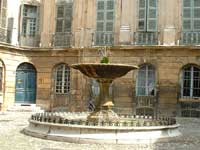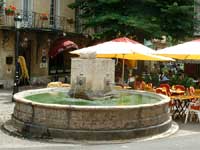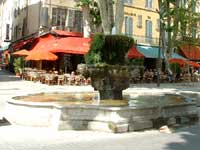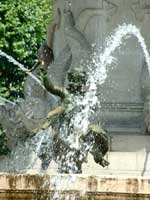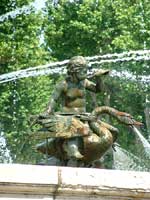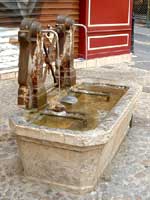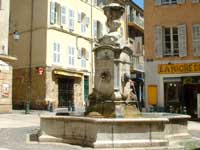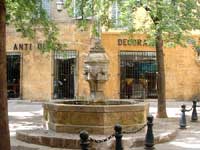| Homepage>>>Tourism>>>Aix en Provence>>>Fountains | ||||||
  |
|
|||||
| " Village of Art, Village of Water ", Aix en Provence
is a thermal water village whose hot and cold water today serve as
the source for among other things more than twenty magnificent fountains
that you'll find all over the town center (centre ville). True works of art, they literally ornament the city making Aix one of France's loveliest cities and giving it the title "City of a Thousand Fountains." The fountains bring a convivial and charming aspect to the city. Take a coffee in the shade of a plane tree (platane) and near the coolness of a streaming fountain and hear its murmuring waters: this is one of the Provencal population's favorite pastimes. The list of fountains that follows will take you across the city and reveal some of Aix's most enchanted places. |
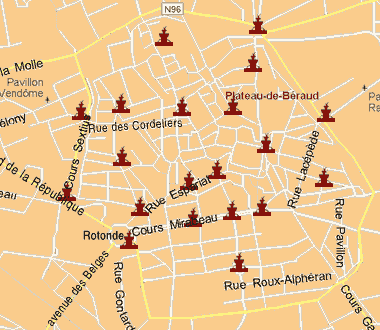
| La fontaine des Quatre Dauphins (The Fountain
of the Four Dolphins) : One of the best-known fountains in Aix en Provence, in the middle of one of the city's most renowned squares. The fountain's name derives from its four highly stylized dolphins who "spit" water directly into the small basin and which support the small center obelisk. The square is as famous as the fountain that gives its name, at the heart of one of the oldest sections of Aix- the Mazarin Quarter. This small square in the shade of four corner trees is an example of the charms and pleasures of strolling through the ancient neighborhoods of Aix. |
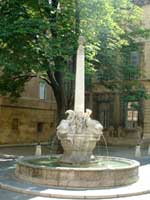 |
|||
| Fountain rue des Bagniers :
In the heart of the pedestrian streets of Aix, the fountain of
the Rue des Bagniers is set into the wall and in it we can see a
medallion of Cézanne
done by Renoir. |
||||
| The Fountain of Place d'Albertas
: |
||||
| The Fountain Pascal :
This fountain owes its name to the industrial company Pascal, which
gifted it to the city in 1922. It is located at the top of Cours
Sextius and is directly fed by the city's thermal water sources. |
||||
| The Fountain Villeverte (Green Village):
Created in two stages, the base was sculpted and put together by
Escursau and the vase on top was then added in 1848; you will discover
this small fountain at the bottom of the Cours Sextius. |
||||
| The Fountain of the Place des Prêcheurs
:
One of the larger fountains of Aix en Provence, this fountain is
second in size only to the fountain of the Rotonde.
Constructed in 1758, the large obelisk at its center is first to
grab your attention- four lions support it and a sphere tops its
summit. |
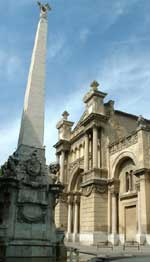 |
|||
The Fountain of the Place des Augustins
:
|
||||
| The Fountain d'Argent (the Fountain of Silver)
:
At the corner of the Rue de la Mule Noire (Street of the Black
Mule) and the old Rue des Jardins, the Fontaine d'Argent is an exquisitely
sculptured piece constructed by the architect Vallon. |
 |
|||
| The Fountain of Fontêtes :
Another of these smaller fountains you'll encounter during your
strolls through the cozy little streets of Aix, this fountain is
to be found at the intersection of Rue Mérindol and the Place
des Cardeurs. |
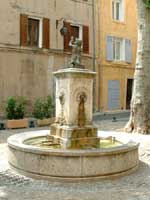 |
|||
The Fountain des Neufs Canons (Fountain
of the Nine Cannons) :
|
||||
| The Fountain of Roi René :
At the end of the Cours
Mirabeau, this fountain appears to dominate the central avenue
of Aix en Provence. The Statue of King Roi Rene, sculpted by David
and based on the designs of Revoil, is nicknamed "Good
King Rene" and is well worth a look. |
 |
|||
The "Mossy" Fountain :
|
||||
|
||||
| The Fountain of the Two Cannons
: |
||||
| Fountain of la Place Bellegarde :
The Place Bellegarde is located at the edge of the centre ville alongside the periphery road which encircles the city. Trees and benches border the square with this large fountain at its center and you can't miss it if you drive around Aix by car. |
 |
|||
| The Fountain of la Place des Tanneurs : | ||||
| The Saint Louis Fountain :
In the manner of the fountain of the Place des Augustins and the fountain of the Place Bellegarde, the Fountain Saint Louis is adorned at its center by a Roman column. It is located at the foot of the Cours des Arts et Métiers and you will notice it immediately as you travel around Aix by car. |
 |
|||
| The Fountain des Trois Ormeaux (Fountain
of the Three Elm Trees) : |
||||
| The Espeluque Fountain :
On the very old Place de l'Archevêché, in the middle
of what is called the Bourg Saint Sauveur, one can find this fountain
which boasts a medallion representing the historian Marcel Provence. |
 |
|||
| The Fountain of the Hôtel
de Ville (Town Hall) :
This majestic fountain, located right in the center of the Place
de l'Hôtel de Ville, was in fact constructed during two
periods. In 1756, the square was decorated with a Column discovered
during archeological digs behind the Hospital Saint Jacques. The
polygonal fountain is surrounded the majority of the time by café
terraces in this square that is so highly appreciated for its cool
temperatures during the summer. |
||||

